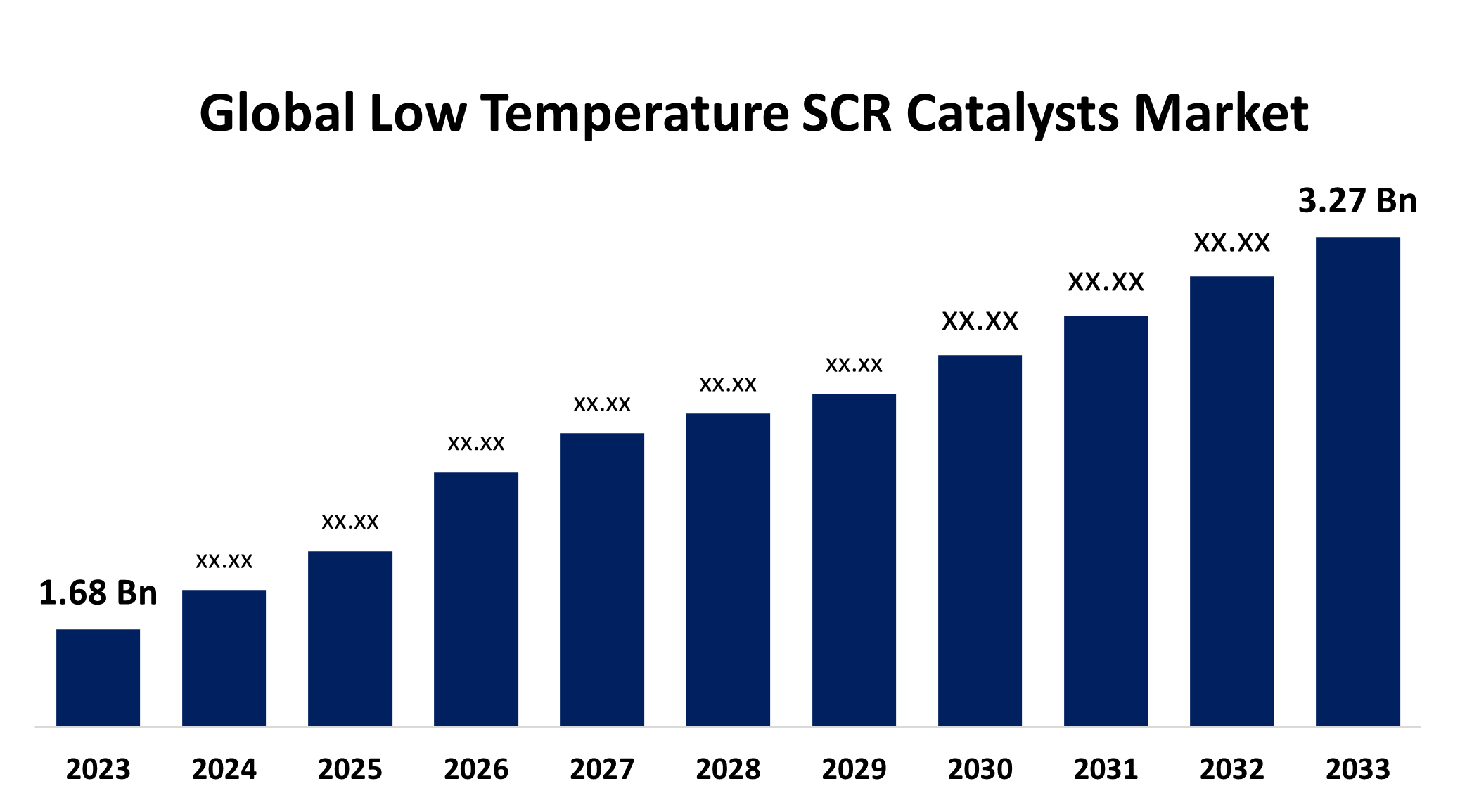Global Low Temperature SCR Catalysts Market Size, Share, and COVID-19 Impact Analysis, By Type (Honeycomb Catalyst, Plate Catalyst, Corrugated Catalyst, and Others), By Application (Power Plants, Cement Plants, Refineries, Steel Plants, and Others), and By Region (North America, Europe, Asia-Pacific, Latin America, Middle East, and Africa), Analysis and Forecast 2023 - 2033.
Industry: Chemicals & MaterialsGlobal Low Temperature SCR Catalysts Market Insights Forecasts to 2033
- The Global Low Temperature SCR Catalysts Market Size was estimated at USD 1.68 Billion in 2023
- The Market Size is Expected to Grow at a CAGR of around 6.89% from 2023 to 2033
- The Worldwide Low Temperature SCR Catalysts Market Size is Expected to Reach USD 3.27 Billion by 2033
- North America is Expected to Grow the fastest during the forecast period.

Get more details on this report -
The Global Low Temperature SCR Catalysts Market Size is expected to cross USD 3.27 Billion by 2033, Growing at a CAGR of 6.89% from 2023 to 2033.
Market Overview
The global low temperature SCR (selective catalytic reduction) catalysts market refers to the industry that develops, manufactures, and applies catalysts to reduce nitrogen oxide emissions at lower operating temperatures. These catalysts are critical components in air pollution control technologies, primarily used in the industrial, power generation, and automotive sectors to meet stringent environmental regulations. Low-temperature SCR catalysts are effective at temperatures ranging from 150°C to 300°C, whereas traditional SCR catalysts require higher temperatures (above 300°C) for optimal performance. These catalysts allow NOx reduction in industries that require high temperatures, such as cement plants, waste incinerators, and marine vessels. The catalyst facilitates a chemical reaction between NOx and a reductant, such as ammonia or urea, converting NOx into harmless nitrogen and water
The low-temperature SCR catalysts market has numerous opportunities for growth and expansion. One of the key opportunities is the growing adoption of cleaner technologies and sustainable practices across industries. As businesses strive to reduce their environmental impact and comply with stringent emission regulations, the demand for efficient emission control technologies, such as low-temperature SCR catalysts, is expected to increase. The growing awareness of air quality and environmental protection, combined with government incentives and regulations, is propelling the use of these catalysts. The development of advanced catalyst materials and designs to improve performance and durability also offers significant growth opportunities.
Report Coverage
This research report categorizes the low temperature SCR catalysts market based on various segments and regions forecasts revenue growth and analyzes trends in each submarket. The report analyses the key growth drivers, opportunities, and challenges influencing the low temperature SCR catalysts market. Recent market developments and competitive strategies such as expansion, type launch, development, partnership, merger, and acquisition have been included to draw the competitive landscape in the market. The report strategically identifies and profiles the key market players and analyses their core competencies in each sub-segment of the low temperature SCR catalysts market.
Global Low Temperature SCR Catalysts Market Report Coverage
| Report Coverage | Details |
|---|---|
| Base Year: | 2023 |
| Market Size in 2023: | USD 1.68 Billion |
| Forecast Period: | 2023 – 2033 |
| Forecast Period CAGR 2023 – 2033 : | 6.89% |
| 023 – 2033 Value Projection: | USD 3.27 Billion |
| Historical Data for: | 2019-2022 |
| No. of Pages: | 267 |
| Tables, Charts & Figures: | 115 |
| Segments covered: | By Type, By Application, By Regional Analysis and COVID-19 Impact Analysis. |
| Companies covered:: | Johnson Matthey Plc, Haldor Topsoe A/S, Cormetech Inc., BASF SE, Hitachi Zosen Corporation, Shell Global Solutions, Clariant AG, Honeywell International Inc., Tenneco Inc., Ceram-Ibiden Co., Ltd., Nippon Shokubai Co., Ltd., DCL International Inc., Envirotherm GmbH, and Other Key Vendors. |
| Pitfalls & Challenges: | COVID-19 Impact, Challenges, Future, Growth, & Analysis |
Get more details on this report -
Driving Factors
The low temperature SCR catalysts market is being driven primarily by increasing environmental regulations aimed at reducing nitrogen oxide emissions. Governments around the world are enforcing stricter emission standards, particularly for industries like power generation, cement manufacturing, and refineries. These regulations require the use of advanced emission control technologies, such as low-temperature SCR catalysts, to meet compliance standards. The growing industrialization and urbanization, combined with increased environmental awareness, are driving up demand for these catalysts. Furthermore, technological advancements in catalyst design and materials are another significant factor driving market growth. Low-temperature SCR catalysts are now more effective at reducing NOx emissions at lower operating temperatures due to innovations such as increased surface area and catalytic activity. These advancements not only broaden the applicability of SCR catalysts across various industrial sectors but also improve their effectiveness, resulting in increased adoption. Investment in R&D by key market players is constantly pushing the boundaries of catalyst performance, making them a more appealing emission control solution.
Restraining Factors
The high cost of installing and maintaining SCR systems is one of the most significant barriers to adoption. The initial investment required to set up SCR systems can be significant, discouraging small and medium-sized businesses from implementing these technologies. Operational and maintenance costs, such as catalyst and component replacement, can also increase overall expenses.
Market Segmentation
The low temperature SCR catalysts market share is classified into type and application.
- The honeycomb catalyst segment held the greatest share in 2023 and is anticipated to grow at a significant CAGR during the forecast period.
Based on the type, the low temperature SCR catalysts market is divided into honeycomb catalyst, plate catalyst, corrugated catalyst, and others. Among these, the honeycomb catalyst segment held the greatest share in 2023 and is anticipated to grow at a significant CAGR during the forecast period. This prominence is attributed to the honeycomb catalyst's large surface area and excellent mass transfer properties, which improve its ability to reduce nitrogen oxide (NOx) emissions. These characteristics make honeycomb catalysts ideal for use in power plants and industrial furnaces, where compact and efficient emission control solutions are required.
- The power plants segment accounted for the majority of the share in 2023 and is estimated to grow at a remarkable CAGR during the projected timeframe.
Based on the application, the low temperature SCR catalysts market is divided into power plants, cement plants, refineries, steel plants, and others. Among these, the power plants segment accounted for the majority of the share in 2023 and is estimated to grow at a remarkable CAGR during the projected timeframe. This dominance is primarily due to the strict environmental regulations imposed on power plants to reduce nitrogen oxide (NOx) emissions. Power plants, particularly those that use fossil fuels, contribute significantly to NOx emissions, necessitating the use of advanced emission control technologies such as low-temperature SCR catalysts. These catalysts are especially effective in power plants because they reduce NOx at lower operating temperatures, increasing energy efficiency and environmental compliance.
Regional Segment Analysis of the Low Temperature SCR Catalysts Market
- North America (U.S., Canada, Mexico)
- Europe (Germany, France, U.K., Italy, Spain, Rest of Europe)
- Asia-Pacific (China, Japan, India, Rest of APAC)
- South America (Brazil and the Rest of South America)
- The Middle East and Africa (UAE, South Africa, Rest of MEA)
Asia Pacific is anticipated to hold the largest share of the low temperature SCR catalysts market over the predicted timeframe.

Get more details on this report -
Asia Pacific is anticipated to hold the largest share of the low temperature SCR catalysts market over the predicted timeframe. One of the primary drivers of market dominance in Asia Pacific is the high concentration of coal-fired power plants, cement factories, steel plants, and refineries in China, India, Japan, and South Korea. These industries are among the largest emitters of nitrogen oxides (NOx), necessitating the widespread use of low-temperature SCR catalysts to meet stringent air pollution control standards. Governments throughout the region have implemented increasingly stringent emission standards, such as China's Ultra-Low Emission (ULE) policy for power plants and India's National Clean Air Programme (NCAP), both of which encourage advanced NOx reduction technologies.
North America is expected to grow at the fastest CAGR growth of the low temperature SCR catalysts market during the forecast period. Stringent emissions standards and advanced industrial infrastructure are driving the growth. The region's established industries, such as power generation, cement manufacturing, and refineries, add to the demand for efficient emission control technologies. The growing emphasis on sustainability and environmental protection, combined with government regulations aimed at lowering NOx emissions, is propelling the use of low-temperature SCR catalysts.
Competitive Analysis:
The report offers the appropriate analysis of the key organizations/companies involved within the low temperature SCR catalysts market along with a comparative evaluation primarily based on their type of offering, business overviews, geographic presence, enterprise strategies, segment market share, and SWOT analysis. The report also provides an elaborative analysis focusing on the current news and developments of the companies, which includes type development, innovations, joint ventures, partnerships, mergers & acquisitions, strategic alliances, and others. This allows for the evaluation of the overall competition within the market.
List of Key Companies
- Johnson Matthey Plc
- Haldor Topsoe A/S
- Cormetech Inc.
- BASF SE
- Hitachi Zosen Corporation
- Shell Global Solutions
- Clariant AG
- Honeywell International Inc.
- Tenneco Inc.
- Ceram-Ibiden Co., Ltd.
- Nippon Shokubai Co., Ltd.
- DCL International Inc.
- Envirotherm GmbH
- Others
Key Target Audience
- Market Players
- Investors
- End-users
- Government Authorities
- Consulting And Research Firm
- Venture capitalists
- Value-Added Resellers (VARs)
Market Segment
This study forecasts revenue at global, regional, and country levels from 2023 to 2033. Spherical Insights has segmented the low temperature SCR catalysts market based on the below-mentioned segments:
Global Low Temperature SCR Catalysts Market, By Type
- Honeycomb Catalyst
- Plate Catalyst
- Corrugated Catalyst
- Others
Global Low Temperature SCR Catalysts Market, By Application
- Power Plants
- Cement Plants
- Refineries
- Steel Plants
- Others
Global Low Temperature SCR Catalysts Market, By Regional Analysis
- North America
- US
- Canada
- Mexico
- Europe
- Germany
- UK
- France
- Italy
- Spain
- Russia
- Rest of Europe
- Asia Pacific
- China
- Japan
- India
- South Korea
- Australia
- Rest of Asia Pacific
- South America
- Brazil
- Argentina
- Rest of South America
- Middle East & Africa
- UAE
- Saudi Arabia
- Qatar
- South Africa
- Rest of the Middle East & Africa
Need help to buy this report?